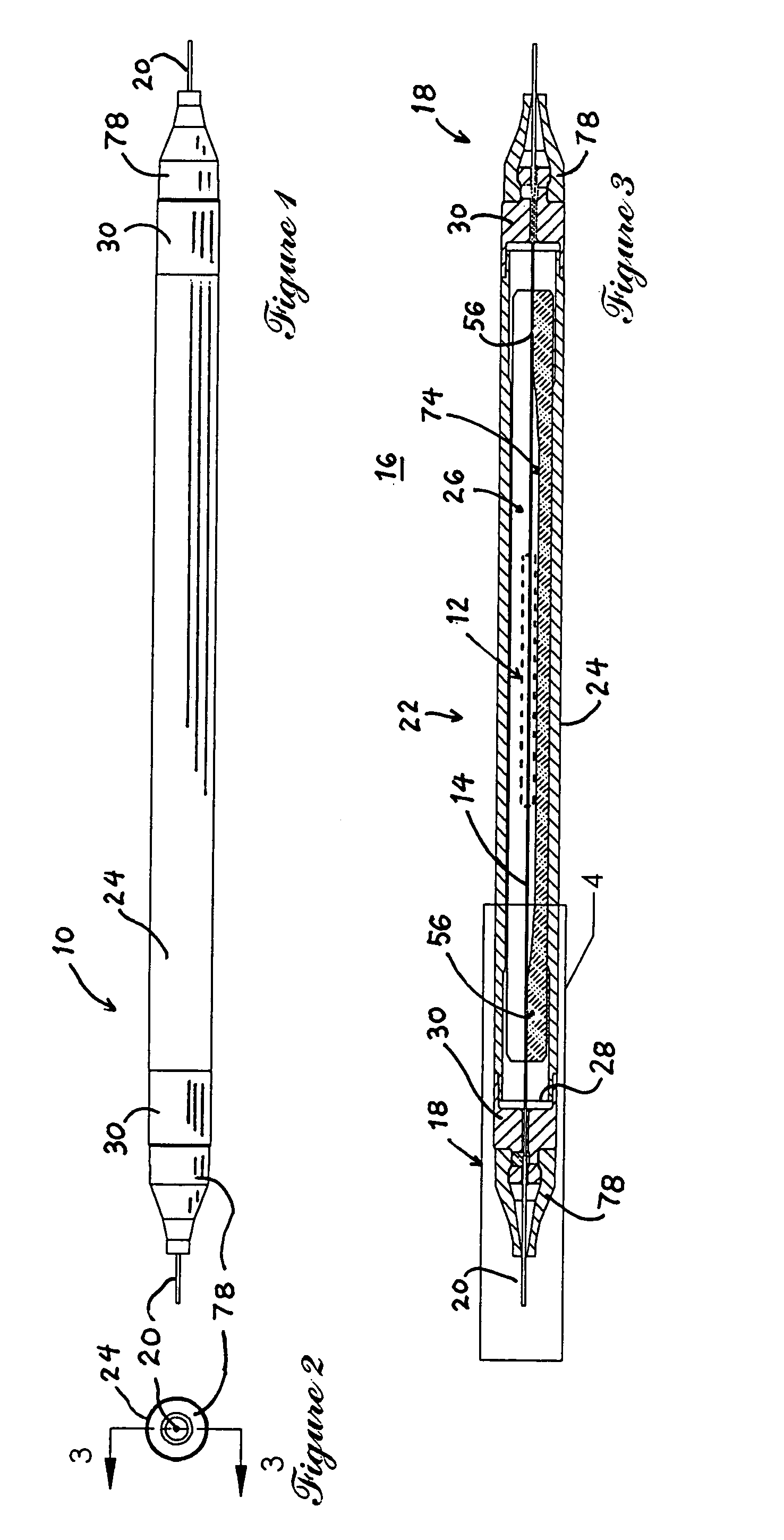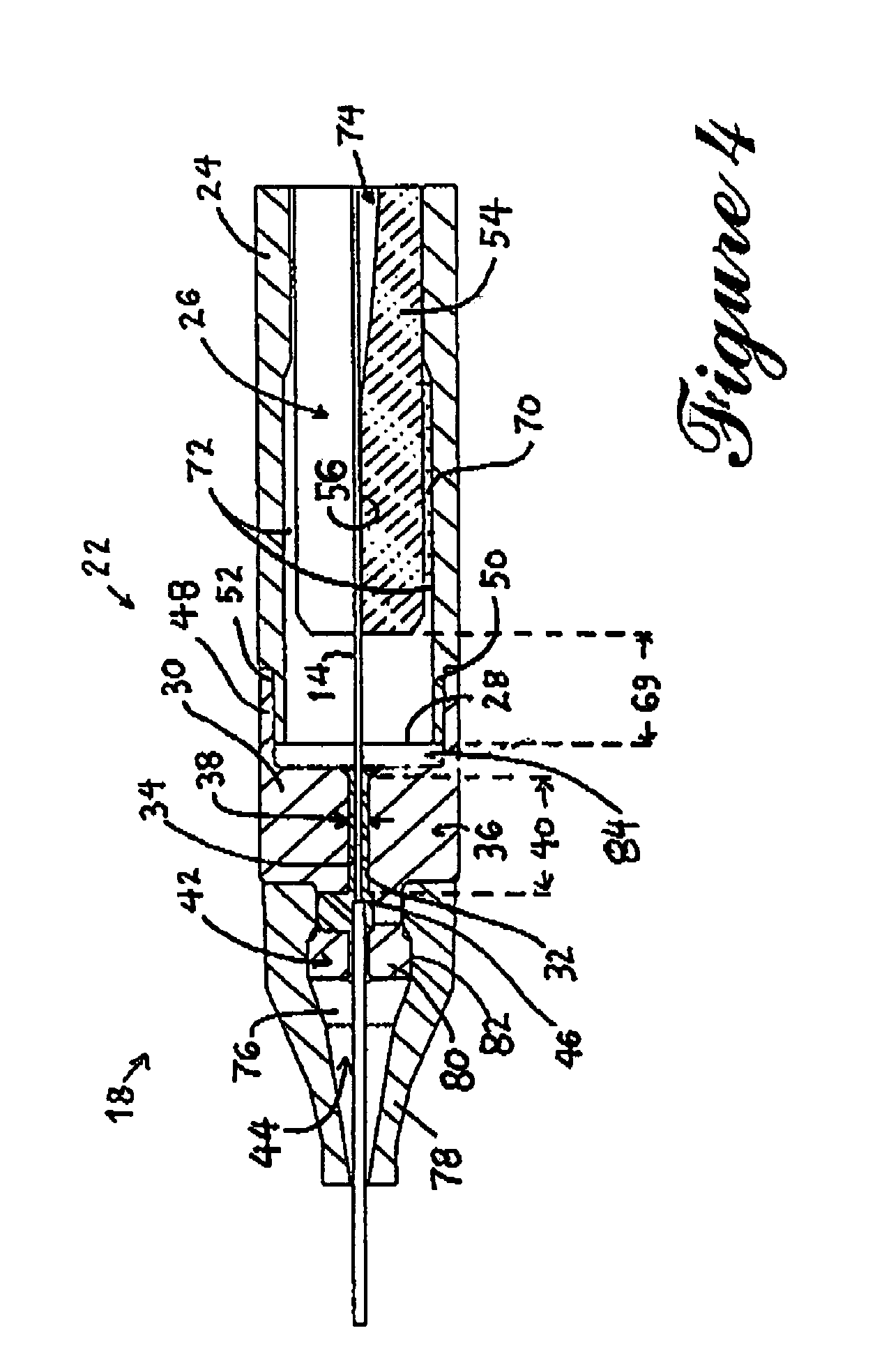Some optical components are particularly vulnerable to mechanical stresses.
In certain instances, this
vulnerability is directly linked to the inherent structure of the optical component.
Indeed, some optical components being made of modified glass fibers, they are characterized by an inherent
brittleness that can lead to
mechanical failure.
The adjacent sections of optical fibers coupled to the optical components are also often particularly vulnerable to mechanical stress, especially if they have been locally stripped of their protective
coating.
Aside from potentially causing breakage of the optical component and / or the adjacent sections of optical fiber attached thereto, bending or other mechanical stresses imposed thereon may potentially cause degradation of optical performances by inducing changes in optical
signal strength and content.
Moisture in particular may prove to be detrimental to some optical components for several reasons.
However, unfortunately, overtones of this
wavelength produce three loss peaks within the 700 to 1600 nm band, and these can interfere with
signal transmission.
Moisture also tends to exaggerate surface flaws and, hence, lower tensile strength of the optical component and strips of optical fiber coupled thereto.
Furthermore, when exposed to
gaseous hydrogen, some optical components show an increase in optical loss that can be either temporary or permanent, depending on whether the
hydrogen simply diffuses into the component and then leaves, or remains long enough to react chemically with the fiber.
One of the main drawbacks associated with the hereinabove mentioned type of prior art optical component packages is that the relatively short and wide
epoxy-based sealing plugs typically do not provide an efficient barrier against
moisture ingress into the tube ends.
Indeed, it is well known that the physical characteristics of cured epoxies are such that they have a tendency to absorb and allow ingress of
moisture.
Most prior art packaging devices using
silicone sealing plugs however are not designed so as to reduce the A / L ratio and, hence, offer relatively poor protection against
humidity ingress.
Another main drawback associated with the hereinabove disclosed type of prior art optical component packages is that the optical component and at least a section of the optical fiber attached thereto are often susceptible of being subjected to mechanical stresses if the optical component
package is subjected to temperature variations.
Temperature variations may prove to be particularly deleterious in situations wherein the optical component and / or the strips of optical fiber attached thereto are solidarly anchored at spaced apart locations to a rigid sealing component and to a fixed mounting fixture within the housing.
In this respect, maintaining the stability and relative position of optical fibers, components and devices, through the correct choice of materials, is particularly critical in that even minor relative movements between such elements may result in large variations or degradation in optical characteristics.
The thermally induced mechanical stresses to which some optical components are subjected to are typically imputable to the mismatch between the coefficients of
thermal expansion of the various components involved.
Indeed, as is well known, when two dissimilar materials are joined together and subjected to thermal
cycling, the difference in their coefficients of
thermal expansion can induce relatively large structural stresses.
Some thermally
induced stress concentration points may potentially damage relatively fragile microstructures.
However, the sealing plugs and the fiber to which they are bound typically remain made out of generally dissimilar classes of material, namely a polymeric material such as
epoxy and a glass-based material such as silica leading to thermally induced mechanical stresses.
However, the use of
silicone is associated with some important drawbacks such as a relatively poor sealing efficiency.
Indeed, sealing plugs made out of
silicone may not form strong chemical bonds with the outer surface of the optical fiber.
Furthermore, silicone releases cyclosiloxane, a contaminant known to induce drift or
wavelength shift in the optical components.
Although solder seals are generally considered as being relatively efficient in preventing contaminant ingress, they nevertheless suffer from numerous drawbacks.
This reduction in the tensile strength of the surface metallized portion may result from factors inherent to the process including the creation of micro-cracks during the removal of the
fiber coating and stresses generated during both metalization and
soldering steps.
Some of the glass-seal structures suffer from the same drawbacks as the hereinabove disclosed other types of seals.
In particular, some of the prior art glass-seal structures suffer from drawbacks associated with mismatches between the coefficient of thermal expansion of the sealing plug and of the housing protecting the fiber.
Although the glass-seal structure disclosed in U.S. Pat. No. 5,664,040 at least partially solves some of the hereinabove mentioned drawbacks associated with other prior art sealing structures, it nevertheless inherently suffers from other drawbacks prohibiting its use in certain settings.
The document mentions the use of a sealing glass preferably having a
softening temperature in the range of about 700° C. to 900° C. This inherently relatively high
softening or temperature may prove to be unacceptable in certain settings, for example when
heat sensitive optical components are packaged especially if thermally sensitive adhesives are also used in the
package.
Furthermore, glass-based sealing materials have also been associated with the release of contaminants during reflow.
These contaminants may potentially induce drift or
wavelength shift in the optical components.
 Login to View More
Login to View More  Login to View More
Login to View More 


